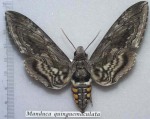 Something is defoliating my tomatoes, potatoes, eggplants, and peppers. What do I do now?
Something is defoliating my tomatoes, potatoes, eggplants, and peppers. What do I do now?
The tomato/tobacco horn worm has to be on the top of every gardeners list of insects to control.
Tobacco horn worm larva is generally green with seven diagonal white lines on the sides and a curved red tipped horn.
Tomato horn worms have eight V-shaped marks on each side and their horn is straighter and blue-black in color. Horn worms are the larvae of hawk or sphinx moths, also known as hummingbird moths.
If you see this moth you can be assured it is up to no good and should be kill if possible.
Tobacco horn worm are generally the most commonly seen of the two, but both can be found and may even be present on the same plant.

Tomato/tobacco horn worms are the largest caterpillars found in this area and can measure up to 4 inches in length. The prominent “horn” on the rear of both gives them their name.
The size of these garden pests allows them to quickly defoliate tomatoes, potatoes, eggplants, and peppers. Occasionally, they may also feed on green fruit. Gardeners are likely to spot the large areas of damage at the top of a plant before they see the culprit.
Horn worms are often difficult to see because of their protective coloring. They are not much for daytime heat of direct sunlight, they tend to feed on the interior of the plant during the day and are more easily spotted when they move to the outside of the plant at dawn and dusk.
Control of horn worms:
* Handpicking. The large size of horn worms makes it easy to get hold of them. Once removed from the plant, they can be destroyed by snipping them in half with shears or dropping them into a bucket of soap water.
* Rototilling (deep digging) your garden, turning up the soil after harvest will help destroy any pupae that may be there.
* Biological. Bacillus thuringensis, or BT (e.g., Dipel, Thuricide), is also considered very effective, especially on smaller larvae. Spray BT as a precautionary measure.

Natural enemies, such as the parasitic wasp that lays its eggs on the horn worm’s back, are common. If found, such worms should be left in the garden so the emerging wasps can parasitize other horn worms.
* Insecticides labeled for horn worm control can be used, products containing carbaryl, permethrin, spinosad insecticides. Read the label carefully before using any insecticide and follow all instructions in their use.
Not from the USA. Please leave me comment about your home town and country.
If you see or read something you like Please Share By Re-blogging, Twitter or Email To A Friend.
Why is common sense so uncommon?
Don’t be shy leave me your comment(s)

We always keep an eye out for tomato horn worms, and rather handpick than try to poison them. Our children love them because they are really interesting and so creepy, haha. Once we found one with those wasp larvae all over it and felt quite sorry for the poor critter, destructive or not.
LikeLike
Interesting post!
LikeLike
Planting borage among tomatoes and things likely to get those ghastly worms also helps deter them quite a bit.
LikeLiked by 2 people
Thanks for the borage companion planting info.
Happy Gardening
LikeLike
I learned so much about the horn worm. The tobacco horn worm is really pretty, even if they are destructive. I didn’t know about the parasitic wasp that lays its eggs on the tobacco horn’s back. Fascinating !! Thanks for sharing, jan
LikeLiked by 1 person
You are welcome I hope the info comes in useful in your garden.
Happy Gardening
LikeLike
Found a horn worm on my Dad’s tomato plants the other day – pesky little things. I did not realize they were moth larvae, though. Very interesting!
LikeLiked by 1 person
Always something!
LikeLiked by 1 person